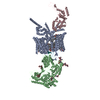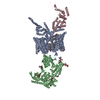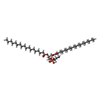+ Open data
Open data
- Basic information
Basic information
| Entry | Database: PDB / ID: 8x90 | ||||||
|---|---|---|---|---|---|---|---|
| Title | P/Q type calcium channel | ||||||
 Components Components | (Voltage-dependent ...) x 3 | ||||||
 Keywords Keywords |  MEMBRANE PROTEIN / MEMBRANE PROTEIN /  voltage-gated calcium channel voltage-gated calcium channel | ||||||
| Function / homology |  Function and homology information Function and homology informationregulation of membrane repolarization during action potential / Presynaptic depolarization and calcium channel opening / positive regulation of high voltage-gated calcium channel activity / calcium ion transmembrane transport via high voltage-gated calcium channel / membrane depolarization during bundle of His cell action potential /  L-type voltage-gated calcium channel complex / cardiac muscle cell action potential involved in contraction / high voltage-gated calcium channel activity / NCAM1 interactions / regulation of ventricular cardiac muscle cell membrane repolarization ...regulation of membrane repolarization during action potential / Presynaptic depolarization and calcium channel opening / positive regulation of high voltage-gated calcium channel activity / calcium ion transmembrane transport via high voltage-gated calcium channel / membrane depolarization during bundle of His cell action potential / L-type voltage-gated calcium channel complex / cardiac muscle cell action potential involved in contraction / high voltage-gated calcium channel activity / NCAM1 interactions / regulation of ventricular cardiac muscle cell membrane repolarization ...regulation of membrane repolarization during action potential / Presynaptic depolarization and calcium channel opening / positive regulation of high voltage-gated calcium channel activity / calcium ion transmembrane transport via high voltage-gated calcium channel / membrane depolarization during bundle of His cell action potential /  L-type voltage-gated calcium channel complex / cardiac muscle cell action potential involved in contraction / high voltage-gated calcium channel activity / NCAM1 interactions / regulation of ventricular cardiac muscle cell membrane repolarization / calcium ion transport into cytosol / regulation of calcium ion transmembrane transport via high voltage-gated calcium channel / L-type voltage-gated calcium channel complex / cardiac muscle cell action potential involved in contraction / high voltage-gated calcium channel activity / NCAM1 interactions / regulation of ventricular cardiac muscle cell membrane repolarization / calcium ion transport into cytosol / regulation of calcium ion transmembrane transport via high voltage-gated calcium channel /  syntaxin binding / neuromuscular junction development / syntaxin binding / neuromuscular junction development /  voltage-gated calcium channel complex / neuronal dense core vesicle / regulation of heart rate by cardiac conduction / calcium ion import across plasma membrane / calcium channel regulator activity / regulation of calcium ion transport / response to amyloid-beta / voltage-gated calcium channel complex / neuronal dense core vesicle / regulation of heart rate by cardiac conduction / calcium ion import across plasma membrane / calcium channel regulator activity / regulation of calcium ion transport / response to amyloid-beta /  voltage-gated calcium channel activity / voltage-gated calcium channel activity /  sarcoplasmic reticulum / cell projection / Regulation of insulin secretion / protein localization to plasma membrane / calcium ion transmembrane transport / modulation of chemical synaptic transmission / Adrenaline,noradrenaline inhibits insulin secretion / cellular response to amyloid-beta / calcium ion transport / sarcoplasmic reticulum / cell projection / Regulation of insulin secretion / protein localization to plasma membrane / calcium ion transmembrane transport / modulation of chemical synaptic transmission / Adrenaline,noradrenaline inhibits insulin secretion / cellular response to amyloid-beta / calcium ion transport /  amyloid-beta binding / positive regulation of cytosolic calcium ion concentration / T cell receptor signaling pathway / chemical synaptic transmission / neuronal cell body / amyloid-beta binding / positive regulation of cytosolic calcium ion concentration / T cell receptor signaling pathway / chemical synaptic transmission / neuronal cell body /  synapse / extracellular exosome / synapse / extracellular exosome /  membrane / membrane /  metal ion binding / metal ion binding /  nucleus / nucleus /  plasma membrane / plasma membrane /  cytosol / cytosol /  cytoplasm cytoplasmSimilarity search - Function | ||||||
| Biological species |   Homo sapiens (human) Homo sapiens (human) | ||||||
| Method |  ELECTRON MICROSCOPY / ELECTRON MICROSCOPY /  single particle reconstruction / single particle reconstruction /  cryo EM / Resolution: 2.95 Å cryo EM / Resolution: 2.95 Å | ||||||
 Authors Authors | Yan, N. / Li, Z. / Cong, Y. / Wu, T. / Wang, T. | ||||||
| Funding support |  China, 1items China, 1items
| ||||||
 Citation Citation |  Journal: Cell Res / Year: 2024 Journal: Cell Res / Year: 2024Title: Structural basis for different ω-agatoxin IVA sensitivities of the P-type and Q-type Ca2.1 channels. Authors: Zhangqiang Li / Ye Cong / Tong Wu / Tongtong Wang / Xinyao Lou / Xinyu Yang / Nieng Yan /  | ||||||
| History |
|
- Structure visualization
Structure visualization
| Structure viewer | Molecule:  Molmil Molmil Jmol/JSmol Jmol/JSmol |
|---|
- Downloads & links
Downloads & links
- Download
Download
| PDBx/mmCIF format |  8x90.cif.gz 8x90.cif.gz | 536.6 KB | Display |  PDBx/mmCIF format PDBx/mmCIF format |
|---|---|---|---|---|
| PDB format |  pdb8x90.ent.gz pdb8x90.ent.gz | 412 KB | Display |  PDB format PDB format |
| PDBx/mmJSON format |  8x90.json.gz 8x90.json.gz | Tree view |  PDBx/mmJSON format PDBx/mmJSON format | |
| Others |  Other downloads Other downloads |
-Validation report
| Arichive directory |  https://data.pdbj.org/pub/pdb/validation_reports/x9/8x90 https://data.pdbj.org/pub/pdb/validation_reports/x9/8x90 ftp://data.pdbj.org/pub/pdb/validation_reports/x9/8x90 ftp://data.pdbj.org/pub/pdb/validation_reports/x9/8x90 | HTTPS FTP |
|---|
-Related structure data
| Related structure data |  38158MC  8x91C  8x93C M: map data used to model this data C: citing same article ( |
|---|---|
| Similar structure data | Similarity search - Function & homology  F&H Search F&H Search |
- Links
Links
- Assembly
Assembly
| Deposited unit | 
|
|---|---|
| 1 |
|
- Components
Components
-Voltage-dependent ... , 3 types, 3 molecules ABC
| #1: Protein | Mass: 287534.312 Da / Num. of mol.: 1 Source method: isolated from a genetically manipulated source Source: (gene. exp.)   Homo sapiens (human) / Gene: CACNA1A, CACH4, CACN3, CACNL1A4 / Production host: Homo sapiens (human) / Gene: CACNA1A, CACH4, CACN3, CACNL1A4 / Production host:   Homo sapiens (human) / References: UniProt: O00555 Homo sapiens (human) / References: UniProt: O00555 |
|---|---|
| #2: Protein |  Voltage-gated calcium channel / Voltage-gated calcium channel subunit alpha-2/delta-1 Voltage-gated calcium channel / Voltage-gated calcium channel subunit alpha-2/delta-1Mass: 126316.148 Da / Num. of mol.: 1 Source method: isolated from a genetically manipulated source Source: (gene. exp.)   Homo sapiens (human) / Gene: CACNA2D1, CACNL2A, CCHL2A, MHS3 / Production host: Homo sapiens (human) / Gene: CACNA2D1, CACNL2A, CCHL2A, MHS3 / Production host:   Homo sapiens (human) / References: UniProt: P54289 Homo sapiens (human) / References: UniProt: P54289 |
| #3: Protein | Mass: 56231.570 Da / Num. of mol.: 1 Source method: isolated from a genetically manipulated source Source: (gene. exp.)   Homo sapiens (human) / Gene: CACNB3, CACNLB3 / Production host: Homo sapiens (human) / Gene: CACNB3, CACNLB3 / Production host:   Homo sapiens (human) / References: UniProt: P54284 Homo sapiens (human) / References: UniProt: P54284 |
-Sugars , 4 types, 7 molecules 
| #4: Polysaccharide | 2-acetamido-2-deoxy-beta-D-glucopyranose-(1-4)-2-acetamido-2-deoxy-beta-D-glucopyranose-(1-4)-2- ...2-acetamido-2-deoxy-beta-D-glucopyranose-(1-4)-2-acetamido-2-deoxy-beta-D-glucopyranose-(1-4)-2-acetamido-2-deoxy-beta-D-glucopyranose / Mass: 627.594 Da / Num. of mol.: 1 / Mass: 627.594 Da / Num. of mol.: 1Source method: isolated from a genetically manipulated source | ||||
|---|---|---|---|---|---|
| #5: Polysaccharide |  / Mass: 424.401 Da / Num. of mol.: 3 / Mass: 424.401 Da / Num. of mol.: 3Source method: isolated from a genetically manipulated source #6: Polysaccharide | 2-acetamido-2-deoxy-beta-D-glucopyranose-(1-4)-2-acetamido-2-deoxy-beta-D-glucopyranose-(1-4)-2- ...2-acetamido-2-deoxy-beta-D-glucopyranose-(1-4)-2-acetamido-2-deoxy-beta-D-glucopyranose-(1-4)-2-acetamido-2-deoxy-beta-D-glucopyranose-(1-4)-2-acetamido-2-deoxy-beta-D-glucopyranose |  / Mass: 830.786 Da / Num. of mol.: 1 / Mass: 830.786 Da / Num. of mol.: 1Source method: isolated from a genetically manipulated source #11: Sugar |  N-Acetylglucosamine N-Acetylglucosamine |
-Non-polymers , 6 types, 14 molecules 










| #7: Chemical | ChemComp-PS1 / | ||||||||
|---|---|---|---|---|---|---|---|---|---|
| #8: Chemical | ChemComp-CLR /  Cholesterol Cholesterol#9: Chemical | ChemComp-PT5 / [( |  Phosphatidylinositol 4,5-bisphosphate Phosphatidylinositol 4,5-bisphosphate#10: Chemical | #12: Chemical | #13: Chemical |  Phosphatidylethanolamine Phosphatidylethanolamine |
-Details
| Has ligand of interest | N |
|---|
-Experimental details
-Experiment
| Experiment | Method:  ELECTRON MICROSCOPY ELECTRON MICROSCOPY |
|---|---|
| EM experiment | Aggregation state: PARTICLE / 3D reconstruction method:  single particle reconstruction single particle reconstruction |
- Sample preparation
Sample preparation
| Component | Name: Voltage-gated P/Q type calcium channel / Type: COMPLEX / Entity ID: #1-#3 / Source: RECOMBINANT |
|---|---|
| Source (natural) | Organism:   Homo sapiens (human) Homo sapiens (human) |
| Source (recombinant) | Organism:   Homo sapiens (human) Homo sapiens (human) |
| Buffer solution | pH: 8 |
| Specimen | Embedding applied: NO / Shadowing applied: NO / Staining applied : NO / Vitrification applied : NO / Vitrification applied : YES : YES |
Vitrification | Cryogen name: ETHANE |
- Electron microscopy imaging
Electron microscopy imaging
| Experimental equipment |  Model: Titan Krios / Image courtesy: FEI Company |
|---|---|
| Microscopy | Model: FEI TITAN KRIOS |
| Electron gun | Electron source : :  FIELD EMISSION GUN / Accelerating voltage: 300 kV / Illumination mode: SPOT SCAN FIELD EMISSION GUN / Accelerating voltage: 300 kV / Illumination mode: SPOT SCAN |
| Electron lens | Mode: BRIGHT FIELD Bright-field microscopy / Nominal defocus max: 1800 nm / Nominal defocus min: 1300 nm Bright-field microscopy / Nominal defocus max: 1800 nm / Nominal defocus min: 1300 nm |
| Image recording | Electron dose: 50 e/Å2 / Film or detector model: GATAN K3 (6k x 4k) |
- Processing
Processing
| EM software | Name: PHENIX / Version: 1.19.2_4158: / Category: model refinement | ||||||||||||||||||||||||
|---|---|---|---|---|---|---|---|---|---|---|---|---|---|---|---|---|---|---|---|---|---|---|---|---|---|
CTF correction | Type: PHASE FLIPPING AND AMPLITUDE CORRECTION | ||||||||||||||||||||||||
3D reconstruction | Resolution: 2.95 Å / Resolution method: FSC 0.143 CUT-OFF / Num. of particles: 118997 / Symmetry type: POINT | ||||||||||||||||||||||||
| Refine LS restraints |
|
 Movie
Movie Controller
Controller





 PDBj
PDBj
























